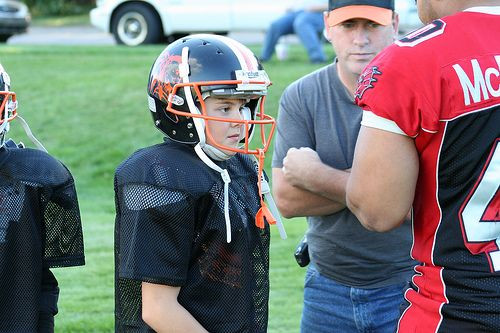Football Helmets And Concussions: There Is No 'Safer' Helmet For Kids To Reduce Risk Of Injury

Despite the vigorous marketing attempts to make one football helmet seem superior to another at reducing a child athlete’s risk of injury, the chances of that actually happening are slim to none, a recent study says.
Each year, about 40,000 sports-related concussions occur in high school football, according to the American Academy of Pediatrics, where the latest study was presented at a conference. These may result from poor tackling techniques or misdiagnosis in-game, but it’s unlikely the players’ equipment factored into how often or to what degree the athletes sustained a sports-related concussion.
Top-of-the-line equipment can set parents back hundreds of dollars compared to the stock gear provided by schools or sold by bargain brands. More expensive options tend to find praise in their ability to reduce shock, protect against cuts and scrapes, and, most importantly, reduce the damage inflicted upon the skull.
The present study used helmets made by the top three manufacturers — Riddell (52 percent), Schutt (35 percent), Xenith (13 percent) — and mouth guards split between generic models (61 percent) and those that had been custom-fitted for the player’s mouth (39 percent), specifically to reduce sports-related concussions. The majority of helmets were made in the last two years, and under one-third was made before 2008.
The study involved 1,332 football players at 36 high schools during the 2012 football season. Players completed a pre-season questionnaire with demographic and injury reports, while athletic trainers recorded incidence and severity of sports-related concussions throughout the year.
"Our preliminary findings suggest that neither any specific brand of football helmet nor custom mouth guards result in fewer concussions in kids who use them," lead co-researcher Dr. Margaret Alison Brooks said in a statement. "Despite what manufacturers might claim, newer and more expensive equipment may not reduce concussion risk. So is it worth the significant extra cost to families and schools?"
The team found 8.5 percent of players in 2012 sustained a sports-related concussion. According to researchers, there was no difference between concussion rates and severity among Riddell users, Schutt users, or Xenith users. Moreover, the rate of concussions was actually higher among specialized mouth guard users than athletes who wore a generic mouth guard.
"As long as the helmet their child is wearing is in good condition, is properly fit and is worn correctly, then the parent shouldn't feel bad if their child is not in a $400 or $500 helmet," Brooks told HealthDay.
More important is the way children are being taught how to tackle, she added. The brain isn’t connected to the skull; it bathes in cerebrospinal fluid and floats, detached, within the person’s head. When someone delivers a crushing hit, normally the hit itself isn’t what causes the concussion. Helmets do succeed at preventing skull fractures. The real damage comes from the movement inside the skull, as the loose brain keeps getting jostled around even after the play has stopped.
“You can dissipate the force of something striking the skull,” Brooks said, “but you can't reduce the forces that make the brain bounce back and forth inside the skull following impact."
Rather than build increasingly tougher equipment, experts argue a more effective solution is teaching young athletes how to tackle properly and avoid leading with their heads. Stronger equipment makes athletes feel invincible, putting protective layers between them and the action. In sports like rugby, proper technique is critical, as any hit you make, you feel.
"In rugby, you can only hit as hard as you can stand to be hit," University of Missouri rugby coach Don Corwin told KOMU-TV recently. "In rugby, you don't have the padding, so you feel the hit just as much."
Without the necessary precautions, Brooks adds, kids who begin football with the assumption that their padding is armor can set them up for a raft of injuries later on — ones that can be avoided if a coach, parent, or other advisor takes the time to explain the sport’s true dangers.
"I personally don't have a problem with more emphasis on enforcing rules that limit contact with the head," she said. "You shouldn't be leading with your head. You shouldn't be tackling with your head. We should be teaching kids that the head should not be the leading point of contact."
Published by Medicaldaily.com



























